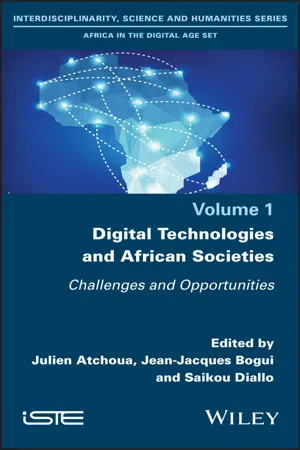
Digital Technologies and African Societies
Challenges and Opportunities
- English
- ePUB (mobile friendly)
- Available on iOS & Android
Digital Technologies and African Societies
Challenges and Opportunities
About This Book
The integration and use of information and communication technologies (ICT) in African countries is increasingly observable in various sectors of activity (banking, education, trade, etc.) despite a digital divide still relevant. ICT has become a major sector of the recent growth of a new informal economy in African cities (Chéneau-Loquay, 2008). This question has been at the heart of various international meetings. An overall positive and even utopian momentum is generally heard about the contribution of digital technologies to the development of African states. The adoption or appropriation of digital technologies by Africans is presented in many speeches by politicians or institutions involved in the field of cooperation and international development as an important issue for the development of this continent. These different considerations give rise to reflections on the following themes. - Social Media and Public Space in Africa - Challenges of the digital economy in Africa - ICT and modernization of higher education in Africa
Frequently asked questions
Information
PART 1
Social Media and the Public Space in Africa
1
Civil Society in the Consolidation Process of Democracy in Burkina Faso: Balai Citoyen on Facebook
“Beyond the political instability that has always characterized Upper Volta, in the 1970s it was able to afford the ‘luxury of democracy’, even if it was ‘a democracy with a military face’ in a regional environment dominated by a single party; it owes it above all to the existence of a combative civil society, which has managed to preserve a minimum level of autonomy in relation to the attempts to control the different regimes that have followed, until the advent of the Burkinabe revolution on August 4, 1983.” (Loada 1999, p. 7)
“to support as closely as possible the evolution of ever more efficient media. Political communication very quickly took hold of the Internet, which has increased its power and considerably extended its area of influence, thanks to its rapid evolution towards Web citizenship, which forms a brand new network of rumors and influence. The relatively recent evolution in the early 2000s from the Internet to Web 2.0 and a much more social and relational set of properties (collaboration, sharing of information and content, personalization, knowledge management, use of social networks, communication) has fostered the emergence of digital social networks that have quickly crystallized politicians’ expectations and desires for transparency, immediacy and proximity to citizens.” (Babau and Eyries 2015, p. 2)
1.1. Problems
1.2. Theoretical and methodological approach
Table of contents
- Cover
- Table of Contents
- Title Page
- Copyright Page
- Foreword
- Introduction
- PART 1: Social Media and the Public Space in Africa
- PART 2: Issues Linked to the Digital Economy in Africa
- PART 3: Digital Technologies and Human Development
- List of Authors
- Index
- Other titles from ISTE in Systems and Industrial Engineering – Robotics
- End User License Agreement